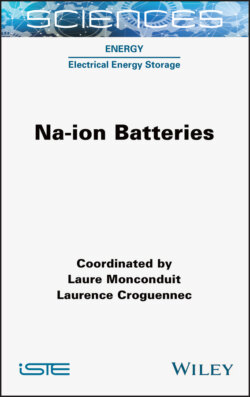Читать книгу Na-ion Batteries - Laure Monconduit - Страница 13
I.2.2. Negative electrodes
ОглавлениеCarbon materials present great interest as negative electrodes because of their low cost and environmental benignity, as well as their excellent electrochemical stability. In LIBs, graphite is the standard negative electrode. It exhibits a low operating voltage and 370 mAh/g specific capacity based on reversible Li deintercalation and reintercalation from/in between the graphene layers. Huge efforts were devoted to using it in NIBs (Stevens and Dahn 2001). Nevertheless, due to the thermodynamic instability of stage 1 Na-GIC formation, graphite was rapidly abandoned as the negative electrode. More recently, it was shown that when used in linear ether solvents, co-intercalation of ether molecules was observed and beneficial for Na+ intercalation in between graphene layers even though it does not lead to acceptable cycles performance (Kim et al. 2015).
As the utilization of graphite as the negative electrode for NIBs failed, non-graphitic carbon materials such as hard carbon and soft carbon have been extensively investigated as alternatives (Dahbi et al. 2014). Chapter 3 discusses the main synthesis routes used to prepare hard carbons and the impact of both the nature of the precursor and synthesis conditions on the hard carbon features. Relationships between these synthesis conditions and the electrochemical properties are discussed in details, with a specific focus on the sodium storage mechanism, still a debate in literature.
Metal oxides have also been intensively studied as potential alternatives to carbon. Due to their low operation voltage as well as low cost and environmental benignity, Ti-based oxide compounds have been widely studied. The conversion reaction compounds based on metal oxides, and extended to sulfides, phosphides, fluorides, etc., have also recently attracted attention because of their high specific capacity involving the exchange of more than one electron per transition metal. These conversion type materials MXn (M active (X) or inactive (Fe, Co, Ni, Cu, Mn, Mo) vs. Na and X = O, S, P, Ge, Sn, Sb, etc.) will be described in Chapter 4. High theoretical capacities, higher than those obtained for carbon-based materials, are also expected for Na-rich alloy phases from the phase diagram of most of p-block elements with Na. Silicon, which is the most studied alloy material for LIB due to the extremely high theoretical specific capacity, has been shown to be quite inactive versus Na. On the contrary, the 14 and 15 group elements with Ge, Sn, P and Sb can show excellent electrochemical behavior, sometimes better than in LIBs, even though they all present a huge volume expansion when alloyed with Na.
